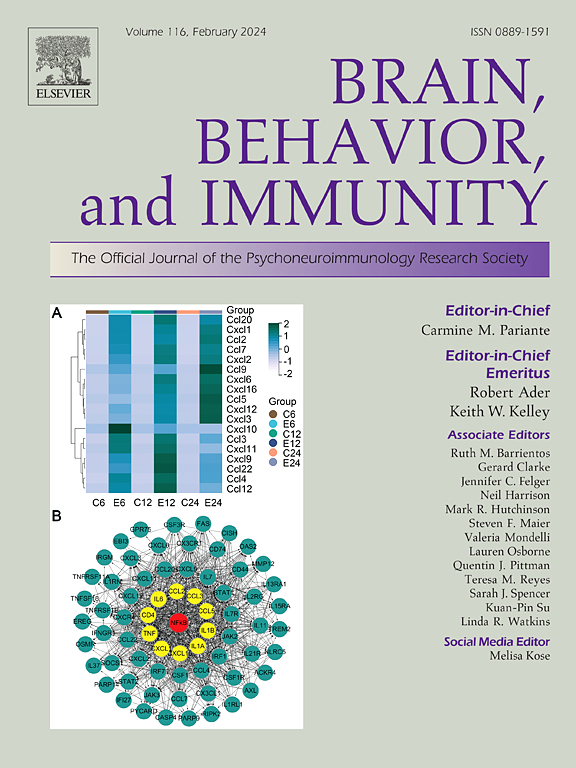减轻 VGluT2 + 脊髓中间神经元上的 sTNF/TNFR1 激活可改善中胸脊髓损伤后的免疫功能
IF 8.8
2区 医学
Q1 IMMUNOLOGY
引用次数: 0
摘要
脊髓损伤(SCI)是一种破坏性疾病,全球每年新增病例 25 万至 50 万。呼吸道感染(如肺炎和流感)是脊髓损伤后死亡的主要原因。遗憾的是,人们对神经-免疫交流的改变如何影响个体的感染结果知之甚少。在人类和啮齿类动物中,脊髓损伤会导致脊髓-交感神经反射(SSR)回路发生不适应性变化,而这一回路对交感神经功能至关重要。免疫功能受损的原因可能与有害的神经炎症有关,这种炎症会损害神经元的平衡功能、可塑性失常和过度兴奋回路。可溶性肿瘤坏死因子(sTNF)是一种促炎症细胞因子,在中枢神经系统损伤后会升高,并在损伤后数月内持续升高。通过药物抑制 SCI 后中枢神经系统中的 sTNF,我们能够证明免疫功能得到了改善。此外,当我们研究可能参与神经-免疫交流改变的特定细胞群时,我们发现兴奋性 IN 上过度的 TNFR1 活性会促进免疫功能障碍。此外,这一观察结果在 VGluT2 + INs 中依赖于 NF-kβ。我们的数据首次报道了中枢神经系统内的一个靶点--TNFR1--会导致T9-SCI后SCI诱导的免疫功能障碍,这也是未来治疗的一个潜在途径。本文章由计算机程序翻译,如有差异,请以英文原文为准。
Mitigating sTNF/TNFR1 activation on VGluT2 + spinal cord interneurons improves immune function after mid-thoracic spinal cord injury
Spinal cord injury (SCI) is a devastating condition with 250,000 to 500,000 new cases globally each year. Respiratory infections, e.g., pneumonia and influenza are the leading cause of death after SCI. Unfortunately, there is a poor understanding of how altered neuro-immune communication impacts an individual’s outcome to infection. In humans and rodents, SCI leads to maladaptive changes in the spinal-sympathetic reflex (SSR) circuit which is crucial to sympathetic function. The cause of the impaired immune function may be related to harmful neuroinflammation which is detrimental to homeostatic neuronal function, aberrant plasticity, and hyperexcitable circuits. Soluble tumor necrosis factor (sTNF) is a pro-inflammatory cytokine that is elevated in the CNS after SCI and remains elevated for several months after injury. By pharmacologically attenuating sTNF in the CNS after SCI we were able to demonstrate improved immune function. Furthermore, when we investigated the specific cellular population which may be involved in altered neuro-immune communication we reported that excessive TNFR1 activity on excitatory INs promotes immune dysfunction. Furthermore, this observation is NF-kβ dependent in VGluT2 + INs. Our data is the first report of a target within the CNS, TNFR1, that contributes to SCI-induced immune dysfunction after T9-SCI and is a potential avenue for future therapeutics.
求助全文
通过发布文献求助,成功后即可免费获取论文全文。
去求助
来源期刊
CiteScore
29.60
自引率
2.00%
发文量
290
审稿时长
28 days
期刊介绍:
Established in 1987, Brain, Behavior, and Immunity proudly serves as the official journal of the Psychoneuroimmunology Research Society (PNIRS). This pioneering journal is dedicated to publishing peer-reviewed basic, experimental, and clinical studies that explore the intricate interactions among behavioral, neural, endocrine, and immune systems in both humans and animals.
As an international and interdisciplinary platform, Brain, Behavior, and Immunity focuses on original research spanning neuroscience, immunology, integrative physiology, behavioral biology, psychiatry, psychology, and clinical medicine. The journal is inclusive of research conducted at various levels, including molecular, cellular, social, and whole organism perspectives. With a commitment to efficiency, the journal facilitates online submission and review, ensuring timely publication of experimental results. Manuscripts typically undergo peer review and are returned to authors within 30 days of submission. It's worth noting that Brain, Behavior, and Immunity, published eight times a year, does not impose submission fees or page charges, fostering an open and accessible platform for scientific discourse.

 求助内容:
求助内容: 应助结果提醒方式:
应助结果提醒方式:


